As a remote state on the northern border of the United States, North Dakota may feel like it is a bit off of the beaten path. Its out-of-the-way location might mean that you would not automatically drive through North Dakota on a road trip. The state does not have any major airports to prompt a layover while flying from one city to another. There are few major sporting events or national entertainment venues that occur in this part of the country. For that reason, North Dakota may seem remote and unknown to many international travelers visiting the United States and even to Americans who have lived in this country their entire lives. However, this article will prove that there are a lot of interesting North Dakota facts that make this state well worth a visit!
We will cover all kinds of fun and unique trivia about the state. Perhaps by the end, you will feel compelled to add it to your list of must-visit places! Let’s dive in to learn all about North Dakota together.
About North Dakota
Before we start exploring 21 facts about the state of North Dakota, let’s first cover the basics. North Dakota is a state in the Great Plains region in the north-central part of the U.S. This region is defined by long expanses of flat land. In North Dakota, that includes prairies, farmland, badlands, and temperate savannas. North Dakota is bordered by the Canadian provinces of Manitoba and Saskatchewan to the north, Montana to the west, South Dakota to the south, and Minnesota to the east. Its capital of Bismarck is the second most populous city in the state, after the slightly larger Fargo. However, with a population estimated at 779,094 in 2022, North Dakota is one of the least densely-populated states in the U.S. Many of these residents live in the cities of Bismarck or Fargo, though others reside in the state’s vast rural areas.
Now, with these basics covered, let’s jump into discovering 21 other fascinating North Dakota facts!

This bridge runs over Valley City, North Dakota.
©Christopher Cagney/iStock via Getty Images
1. North Dakota was the 39th State to Join the U.S.
First on the list of interesting North Dakota facts is that this state joined the Union on November 2, 1889. This makes it the 39th state to become part of the U.S. In fact, it was admitted to the Union at the same time as its southern neighbor of South Dakota, which became the 40th state simply due to alphabetical order (the “N” of “north” comes before the “S” of “south”).
2. North Dakota is the 19th Largest State by Size
With 70,705 square miles of land, North Dakota is a pretty vast state! North Dakota is roughly 340 miles from east to west and 211 miles from north to south. This makes it much larger than many states in the eastern part of the country, but smaller than other large states in the west and southwest. At any given time, between 2 and 4% of this land can be covered in water.
3. North Dakota is the 4th Least Populous State
With a population estimated at only 779,094 in 2022, North Dakota is among the least-populated states in the U.S.! In fact, it is the 4th least populous and the 4th most sparsely populated. The only states with fewer people are Alaska, Vermont, and Wyoming, with Wyoming taking the prize as the least-populated state with only about 581,000 residents as of 2022 estimates.
4. The Highest Point in North Dakota is White Butte
The highest point in the state is White Butte. White Butte in the southwestern corner of North Dakota. It stands at 3,506 feet above sea level.
5. The Lowest Point in North Dakota is at Red River at Pembina
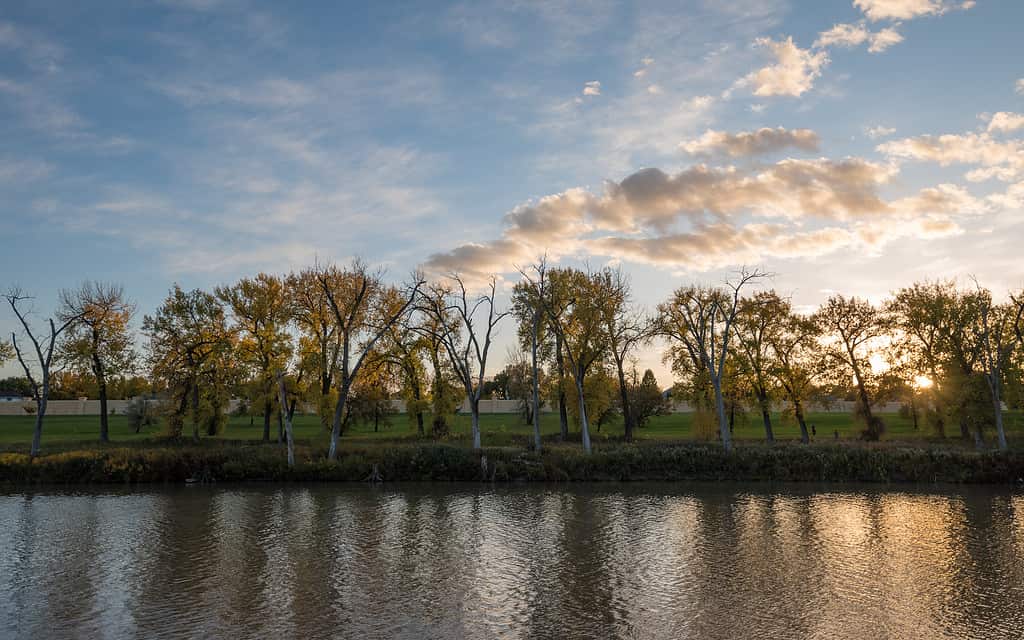
The Red River is one of the defining geographic features of North Dakota.
©Tony Webster / CC BY-SA 2.0 – License
The lowest point in the state is at 750 feet above sea level, at a point where the Red River flows into Manitoba. This is in Pembina in northeastern North Dakota. Pembina is a small town situated on the border of the United States and Canada. If you are an adventurer, it could be a great place to visit, with beautiful vistas and fantastic opportunities for outdoor exploration. Pemina is also important to the state’s history. Early explorers and traders used the Red River to travel from Canada in the 1700s and establish fur trade posts. Many of the earliest permanent European settlers came from Canada. Many were also involved with trade.
6. North Dakota Leads the Country in Honey Production
Did you know that North Dakota is the top producer of honey in the United States? It’s true! In 2022 alone, bees in North Dakota produced 31.2 million pounds of honey! Together, all of that honey had a value of over $82 million. This state has been the top honey-producing state for many years. In fact, North Dakota has often produced double the honey as in any other state. The state’s ability to achieve this national record is partly due to the environment, which is very conducive to honey bee thriving. Cold nights and warm summer days help the flowers in North Dakota to secrete a lot of nectar. This nectar becomes delicious, sweet honey for the local honeybees!
7. North Dakota Leads the Country in the Production of Many Agricultural Goods

Soybeans are one of the many agricultural crops produced on farms in North Dakota.
©Cavan-Images/Shutterstock.com
This state is also a big agricultural producer. In fact, North Dakota leads the country in the production of goods like spring wheat, durum wheat, dry edible peas, edible beans, flaxseed, and canola.
8. The Little Missouri National Grasslands is the Largest Grassland in the U.S.
North Dakota has three grasslands within its borders. However, at over 1 million acres, the largest is Little Missouri National Grasslands. At over 1,033,271 acres, this grassland area is the largest in the entire United States! Located in western North Dakota, this grassland includes Theodore Roosevelt National Park. The highest point in the state, White Butte, sits within the extreme southeast corner of the grassland, near the town of Amidon.
9. North Dakota’s Border is Home to the International Peace Garden
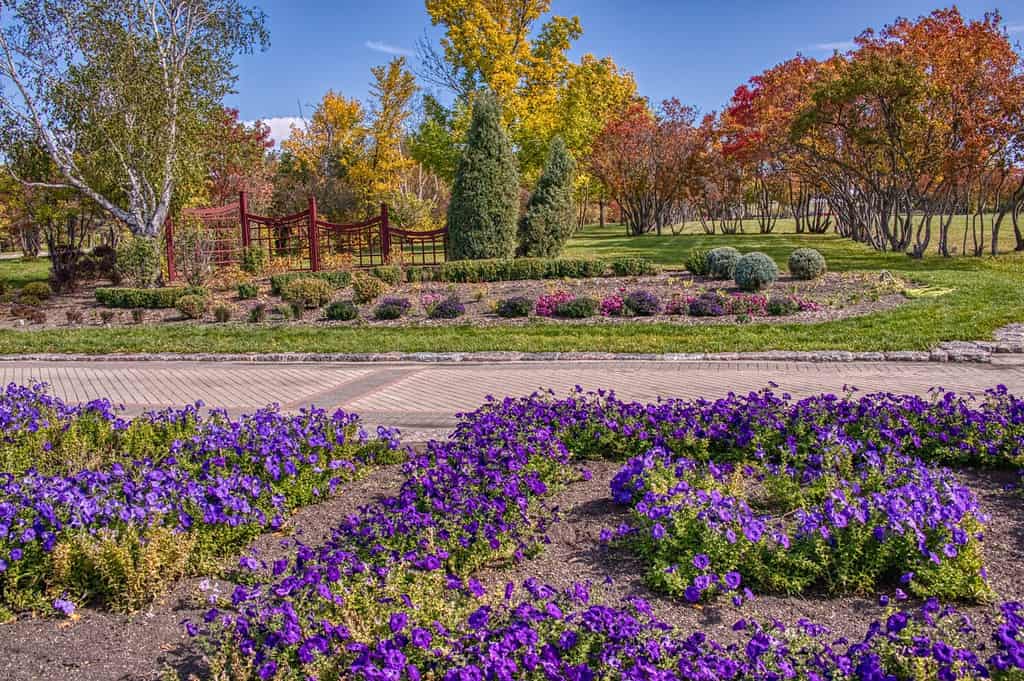
The International Peace Garden is focused on promoting peace and friendship between Canada and the United States.
©Jacob Boomsma/Shutterstock.com
As a state in the U.S. that shares a long border with Canada, North Dakota also has a beautiful symbol of friendship and cooperation between the two countries. The International Peace Garden straddles the line of U.S. and Canada, sitting on the border of North Dakota and Manitoba.
10. North Dakota Has More Wildlife Refuges Than Any Other State
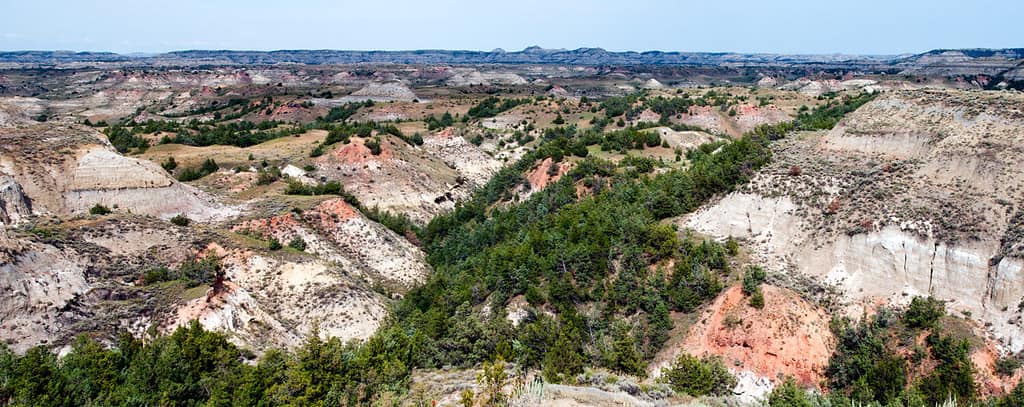
The badlands at Theodore Roosevelt National Park in North Dakota are among the state’s many protected areas.
©RhysFoto/Shutterstock.com
With 63 wildlife refuges in its borders, North Dakota has more than any other state! These areas protect large swaths of habitat for birds, mammals, and reptiles. They also preserve many native plants and features of the natural landscape.
11. The Official State Flower is the Wild Prairie Rose
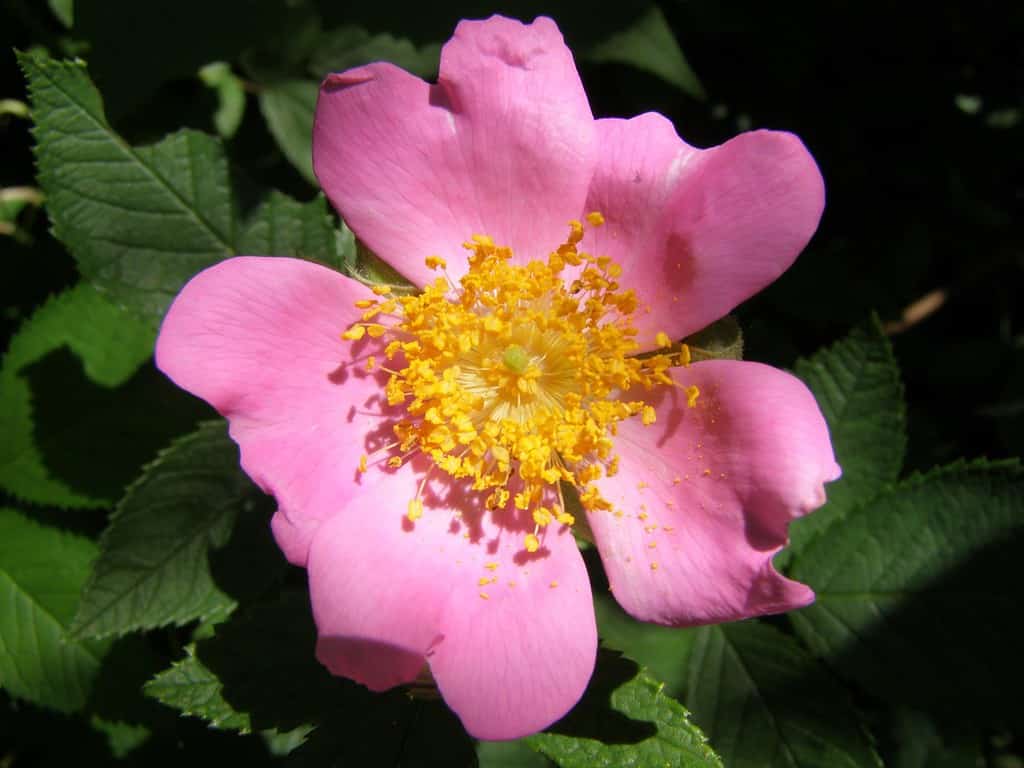
The wild prairie rose is the official state flower of North Dakota.
©Photoglitz/Shutterstock.com
North Dakota’s official state flower is a beautiful emblem of the natural landscape that includes huge meadows and prairies. North Dakota designated the wild prairie rose as its official state flower in 1907. The wild prairie rose comes in three species: the Rosa Blanda, Arkansana, and Pratincula. This small rose grows fragrant pink flowers and blooms in the months of May through September throughout the meadows and roadsides across North Dakota.
12. North Dakota is the Least-Visited U.S. State
North Dakota does not get a lot of attention! Without some of the famous national parks, like Yellowstone or Mount Rushmore, and few major attractions, there is not a lot to attract visitors to this northern state. However, for those who want to avoid the crowds, this could be a benefit! Visiting North Dakota will give plenty of opportunities to enjoy a natural landscape, tranquil atmosphere, and quiet towns without the rush of tourists. This is the place for introverts to visit!
13. The Official State Tree is the American Elm
In 1947, North Dakota designated the American elm tree as the official state tree. The American elm grows commonly throughout the state, often reaching heights of 120 feet or growing even taller. This tree is native to North America and grows from Nova Scotia to Alberta and Montana, and as far south as Florida.
14. Rugby, North Dakota Might Be the Center of North America
Have you thought about the geographical center of the continent? For a long time, North Dakota claimed that it contained the point directly in the middle of North America! The town with this distinction is called Rugby. Originally founded in 1886 at a junction on the Great Northern Railway, the town has long been a hub for events and activities in North Dakota. Though whether or not Rugby is actually the true geographic center of the continent has recently come up for debate, the town still has a monument proclaiming itself as the center of North America.
15. North Dakota’s State Beverage is Milk

The Salem Sue cow statue in North Dakota reflects how important the dairy industry is to the state’s people and economy.
©amanderson2 / Flickr – License
With so many farmers, the dairy industry is an important part of the economy and society of North Dakota. To reflect its important role, the North Dakota legislative assembly declared milk to be the official state beverage in 1983.
16. “Dakota” Comes from the Sioux People

Sioux Chief Gall, a leader of the Sioux people, was born in 1840 and died in 1894.
©iStock.com/Christine_Kohler
Long before European people came to North America, the lands now known as North and South Dakota were inhabited by Native tribes. The Sioux tribes, which includes the Dakota, Lakota, and Nakota people lived in the Great Plains region. This area includes the present-day states of North Dakota, South Dakota, Kansas, Nebraska, Wyoming, Montana, Oklahoma, Texas, and Colorado. The Sioux tribes were a strong hunting culture and dominated the area for a long time. However, the arrival of European settlers threatened the Sioux tribes’ way of life. Eventually, the newcomers pushed the Sioux people into small reservations, opening up most of the land for white settlers.
However, when President James Buchanan signed a bill creating the Dakota Territory (which would become the two Dakota states, Montana, and Wyoming), he kept the name of the Dakota, or Sioux, Native tribe.
17. The Smallest City in North Dakota is Maza
With a population of only about 10 people, the smallest town in North Dakota is a tiny place called Maza.
18. The Largest City in North Dakota is Fargo
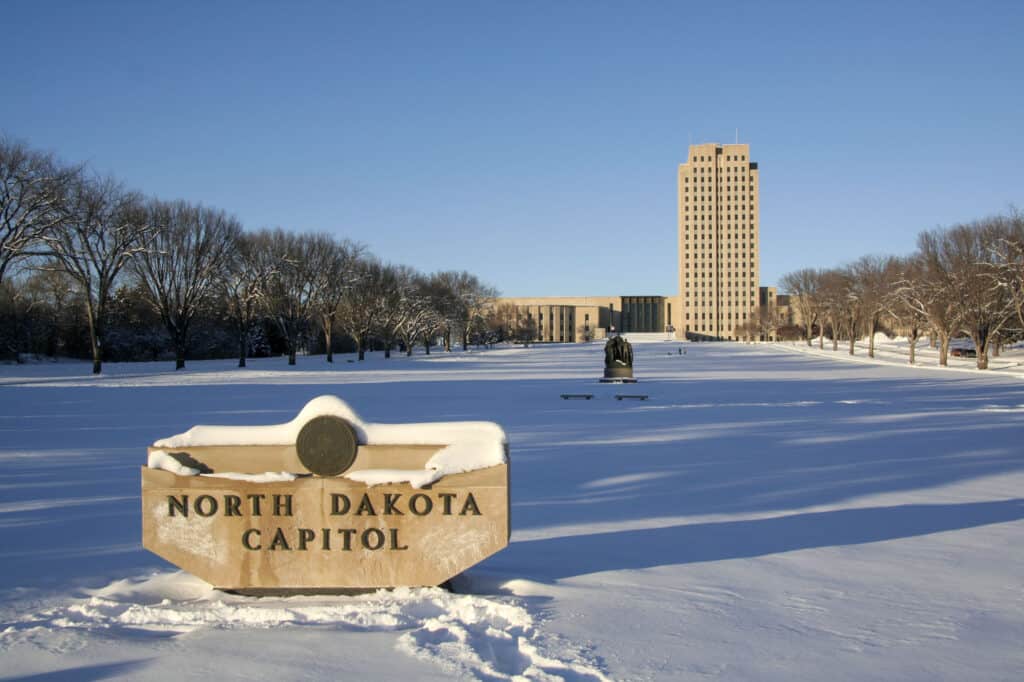
Bismarck, North Dakota is the state capital and second-biggest city.
©iStock.com/sakakawea7
Fargo is the largest city in North Dakota. It is the county seat of Cass County. At the 2020 census, Fargo had a population of 125,990. This city lies along the Red River, very close to the Minnesota state border. Just across the river is the city of Moorhead, Minnesota. Though Fargo is still a relatively small city, its lively residents and vibrant culture makes it a dynamic and exciting place to live. The second-largest city in North Dakota is the capital of Bismarck.
19. North Dakota is Famous for Its Sunflowers
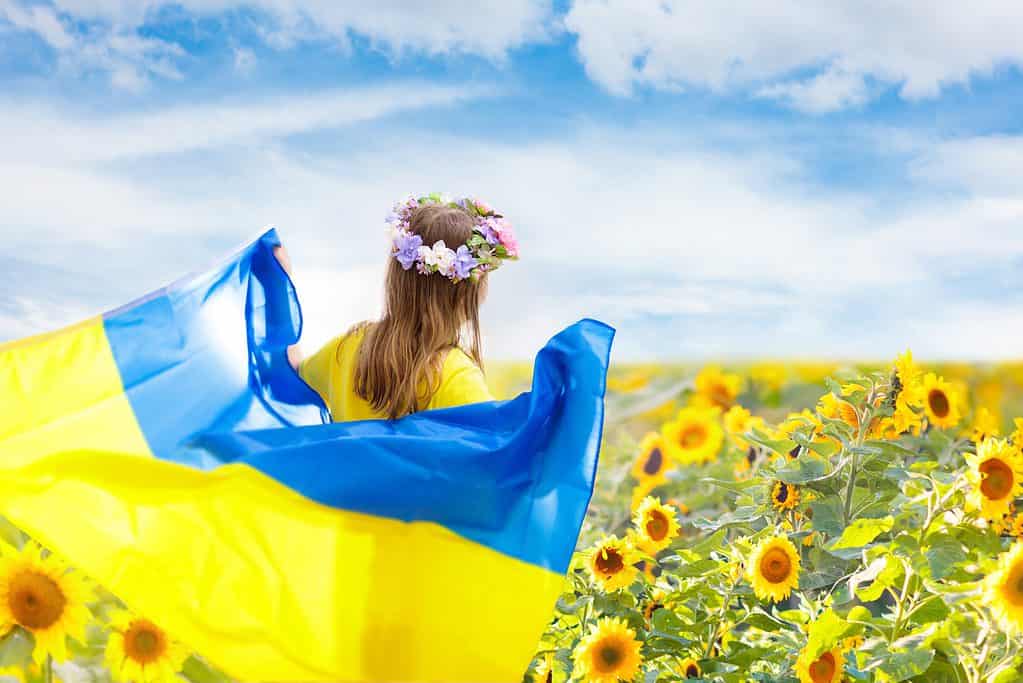
Sunflowers are a visible part of Ukrainian culture, representing the country’s spirit and identity. North Dakota’s large fields of sunflowers are a result of Ukrainian immigrants who planted them in the 19th and 20th centuries.
©FamVeld/Shutterstock.com
Visit North Dakota in August, and you may see vast sunflower fields blanketing the land of North Dakota. August is the peak of the growing season, when the flowers are at their largest and most vibrant. Dating back to the 19th and early 20th century, Ukrainian immigrants who moved to North Dakota with the Homestead Act of 1862 started planting sunflowers. More than 100 years later, the sunflowers of North Dakota are still an important part of the economy and a symbol of state pride. They start blooming in July and continue bringing color with their cheery yellow flower heads through August. They bring joy as well as contribute to the production of sunflower seeds and the flower market. In fact, North Dakota produces almost 762 billion pounds of sunflowers a year!
If you are looking for a reason to visit North Dakota, this might just be it! Visit at the end of the summer and find a field of beautiful sunflowers.
20. North Dakota Has Super Fast Internet
Did you know that North Dakota is ranked second in the country for fastest internet access? 30% of households in the state have access to internet faster than 1 Gbps (billions of bits per second)! This super speedy internet keeps North Dakota residents connected and spurs on the growing tech economy of the state.
21. The Enchanted Highway Has a Quirky Collection of Scrap Metal Sculptures

“Geese in Flight” is one of the scrap metal sculptures along North Dakota’s “Enchanted Highway.”
©Skvader / CC BY-SA 4.0 – License
Travel along 32 miles of Highway 21’s two-lane road in southwestern North Dakota, and you might start to see some unique sculptures! This “Enchanted Highway” is dotted with scrap metal artworks. Starting with “Geese in Flight” at Exit 72 of I-94, you can travel along a tour of large metal sculptures that appear along the county road, each with its own dedicated parking area and viewing spot. With sculptures including “Deer Crossing,” “Theodore Roosevelt Rides Again,” the “World’s Largest Tin Family,” and more, you will surely be delighted and awed by these incredible works dotting the side of Highway 21.
The photo featured at the top of this post is © Jacob Boomsma/Shutterstock.com
Thank you for reading! Have some feedback for us? Contact the AZ Animals editorial team.







